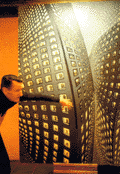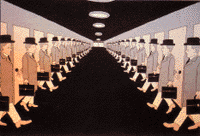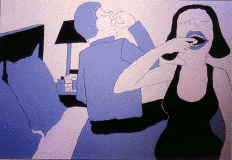By: Jostein Mosnes
Photo: Hans Bøvre |
|

|
|
 Last winter, the eyes of the art world were focused on a very special exhibition in Nor-way: After a lengthy seif-impo-sed exile from the public eye, Pushwagner, a Norwegian artist chose to exhibit his works in the Skien Art Association Gallery. The effect of this exhibition has been remarkable Oslo's new-spapers mobilized their most se-asoned culture-vultures. On te-levision, Saddam Hussein was given a brief rest, and viewers received a few minutes of Push-wagner's apocalyptic work. Later this year, the exhibition floo-r of the H¿vikodden Art Center wil be cleared to make room for is production. At 50, Push-wagner has finally come of age. Last winter, the eyes of the art world were focused on a very special exhibition in Nor-way: After a lengthy seif-impo-sed exile from the public eye, Pushwagner, a Norwegian artist chose to exhibit his works in the Skien Art Association Gallery. The effect of this exhibition has been remarkable Oslo's new-spapers mobilized their most se-asoned culture-vultures. On te-levision, Saddam Hussein was given a brief rest, and viewers received a few minutes of Push-wagner's apocalyptic work. Later this year, the exhibition floo-r of the H¿vikodden Art Center wil be cleared to make room for is production. At 50, Push-wagner has finally come of age.
The exhibition's central com-position is the series of paintings entitled " A day in the life of the Mann family". The series inevi-tably brings back memories of Aldous Huxiey's " Brave New World ".A parody of our own civilization. The naive and the grotesque in a strange union -the real world and our fantasies.
In yet another work, the language of the artist is more explicit. With total accuracy, the world explodes in a mixture of Star Wars and the Revelation. We start to wonder: just who is this Push-wagner?
He was christened Terje Brofoss. Bom in Oslo in 1940. His artist's name is a genuine invention of the hippie era. Hariton Pushwagner. Hariton stands for" Hari "as in" Hari Krishna" - the "ton" added on just for the weight. "Pushwagner" is a peculiar allegory to the shopping carts found in most supermarkets. A slight thumbing of tbe nose at our consumer oriented society.
 Brofoss graduated from the Norwegian National School of Art in 1959. That same year he went on a study tour to Spain and Marocco. An "obligatory" study tour to Italy followed. "But for me, the stay there was no immersion in Roman culture. From the port of Trieste, I travelled, via Jugoslavia to Lebanon, Israel and Syria. I travelled alone and didn't retum to Norway until the following year." Brofoss graduated from the Norwegian National School of Art in 1959. That same year he went on a study tour to Spain and Marocco. An "obligatory" study tour to Italy followed. "But for me, the stay there was no immersion in Roman culture. From the port of Trieste, I travelled, via Jugoslavia to Lebanon, Israel and Syria. I travelled alone and didn't retum to Norway until the following year."
"Moorish and Arabian mosaic art inspired and influenced me - not thematically, but by the sheer power of its impressive richness of details. Details that expressed the artist's professional craftsmanship and handiwork. To me, perfection is especially important!"
Brofoss gives us a friendly gaze. His outfit seems more middle class than academic. But despite his appearance, we are aware of a driving force behind the mild mask. And we have a nervous feeling that we are privileged to be granted some patience. When our photographer dares to ask about tlae opening hours of the local shops, Pushwagner sharply comments through the smoke of his cigarette : ''You're in the middle of the Bible Belt, my friend. The sale of all fluids ceases at exactly 4 p.m.!
 As we point out that it's actually camera film we are after, we suddenly become aware of the crowd in the cafe'. Brofoss' straightforward reference to thc religious mores of the community result m a nervous rattle of coffee cups.. The atmosphere i charged. Brofoss exudes an odor of New York jungle. "At an early stage I becamc fascinated with America. While allied bombs were being dropped on Nazi Germany, I was a four year old, drawing sketches of the Wright brothers' first aeroplanes. The most interesting thing was that already at that age I was able to draw in perspective, which was aptly commented on by my father. After the war, everyone went crazy about America, and I continued to draw ostentatious American cars like Cadillacs and Packards. Early in the 50Õs my attention was drawn to a record cover attist named Ben Shan. He designed the covers of Benny Goodman's records as well as other musicians. He was a great inspiration to me. Later I was taken with such different attists as Lars Hettervig, Edvard Munch, Vincent van Gogh, and Modigliari. As we point out that it's actually camera film we are after, we suddenly become aware of the crowd in the cafe'. Brofoss' straightforward reference to thc religious mores of the community result m a nervous rattle of coffee cups.. The atmosphere i charged. Brofoss exudes an odor of New York jungle. "At an early stage I becamc fascinated with America. While allied bombs were being dropped on Nazi Germany, I was a four year old, drawing sketches of the Wright brothers' first aeroplanes. The most interesting thing was that already at that age I was able to draw in perspective, which was aptly commented on by my father. After the war, everyone went crazy about America, and I continued to draw ostentatious American cars like Cadillacs and Packards. Early in the 50Õs my attention was drawn to a record cover attist named Ben Shan. He designed the covers of Benny Goodman's records as well as other musicians. He was a great inspiration to me. Later I was taken with such different attists as Lars Hettervig, Edvard Munch, Vincent van Gogh, and Modigliari.
For the last 20 years his main piece of work" A day in the life of the Mann family" ha.s haunted Brofoss like a helpless child. In 1980 he attempted to free himself of this with an exhibiton at the Hovikodden Art Center, but the public interest was rather poor. In 1988, he was a part of the Chelsea Hotel milieu in New York, where the final version of the work was created. The series aroused attention in American art circles. Brofoss couldn't finance an exhibition himself. With the exhibition in Skien, a major work of modem Norwegian art has. been secured for the home front..
Sidene er laget av Webmaster
|

